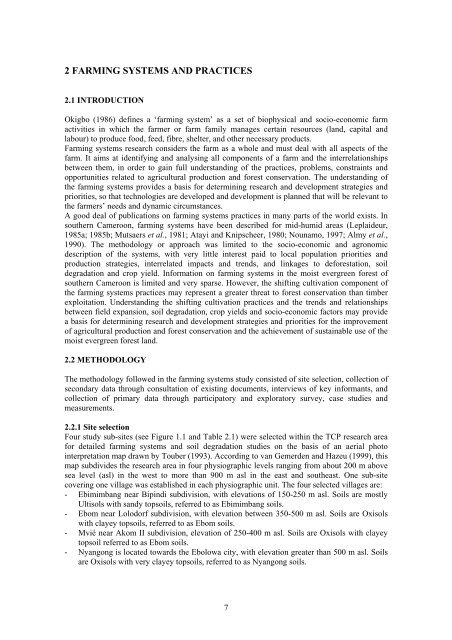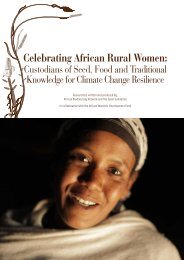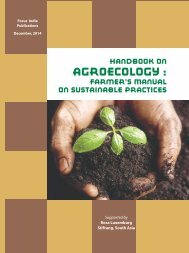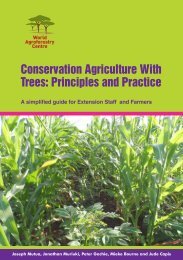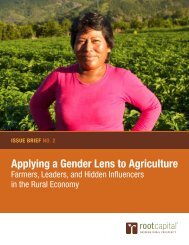1t0SC7l
1t0SC7l
1t0SC7l
Create successful ePaper yourself
Turn your PDF publications into a flip-book with our unique Google optimized e-Paper software.
2 FARMING SYSTEMS AND PRACTICES<br />
2.1 INTRODUCTION<br />
Okigbo (1986) defines a ‘farming system’ as a set of biophysical and socio-economic farm<br />
activities in which the farmer or farm family manages certain resources (land, capital and<br />
labour) to produce food, feed, fibre, shelter, and other necessary products.<br />
Farming systems research considers the farm as a whole and must deal with all aspects of the<br />
farm. It aims at identifying and analysing all components of a farm and the interrelationships<br />
between them, in order to gain full understanding of the practices, problems, constraints and<br />
opportunities related to agricultural production and forest conservation. The understanding of<br />
the farming systems provides a basis for determining research and development strategies and<br />
priorities, so that technologies are developed and development is planned that will be relevant to<br />
the farmers’ needs and dynamic circumstances.<br />
A good deal of publications on farming systems practices in many parts of the world exists. In<br />
southern Cameroon, farming systems have been described for mid-humid areas (Leplaideur,<br />
1985a; 1985b; Mutsaers et al., 1981; Atayi and Knipscheer, 1980; Nounamo, 1997; Almy et al.,<br />
1990). The methodology or approach was limited to the socio-economic and agronomic<br />
description of the systems, with very little interest paid to local population priorities and<br />
production strategies, interrelated impacts and trends, and linkages to deforestation, soil<br />
degradation and crop yield. Information on farming systems in the moist evergreen forest of<br />
southern Cameroon is limited and very sparse. However, the shifting cultivation component of<br />
the farming systems practices may represent a greater threat to forest conservation than timber<br />
exploitation. Understanding the shifting cultivation practices and the trends and relationships<br />
between field expansion, soil degradation, crop yields and socio-economic factors may provide<br />
a basis for determining research and development strategies and priorities for the improvement<br />
of agricultural production and forest conservation and the achievement of sustainable use of the<br />
moist evergreen forest land.<br />
2.2 METHODOLOGY<br />
The methodology followed in the farming systems study consisted of site selection, collection of<br />
secondary data through consultation of existing documents, interviews of key informants, and<br />
collection of primary data through participatory and exploratory survey, case studies and<br />
measurements.<br />
2.2.1 Site selection<br />
Four study sub-sites (see Figure 1.1 and Table 2.1) were selected within the TCP research area<br />
for detailed farming systems and soil degradation studies on the basis of an aerial photo<br />
interpretation map drawn by Touber (1993). According to van Gemerden and Hazeu (1999), this<br />
map subdivides the research area in four physiographic levels ranging from about 200 m above<br />
sea level (asl) in the west to more than 900 m asl in the east and southeast. One sub-site<br />
covering one village was established in each physiographic unit. The four selected villages are:<br />
- Ebimimbang near Bipindi subdivision, with elevations of 150-250 m asl. Soils are mostly<br />
Ultisols with sandy topsoils, referred to as Ebimimbang soils.<br />
- Ebom near Lolodorf subdivision, with elevation between 350-500 m asl. Soils are Oxisols<br />
with clayey topsoils, referred to as Ebom soils.<br />
- Mvié near Akom II subdivision, elevation of 250-400 m asl. Soils are Oxisols with clayey<br />
topsoil referred to as Ebom soils.<br />
- Nyangong is located towards the Ebolowa city, with elevation greater than 500 m asl. Soils<br />
are Oxisols with very clayey topsoils, referred to as Nyangong soils.<br />
7


